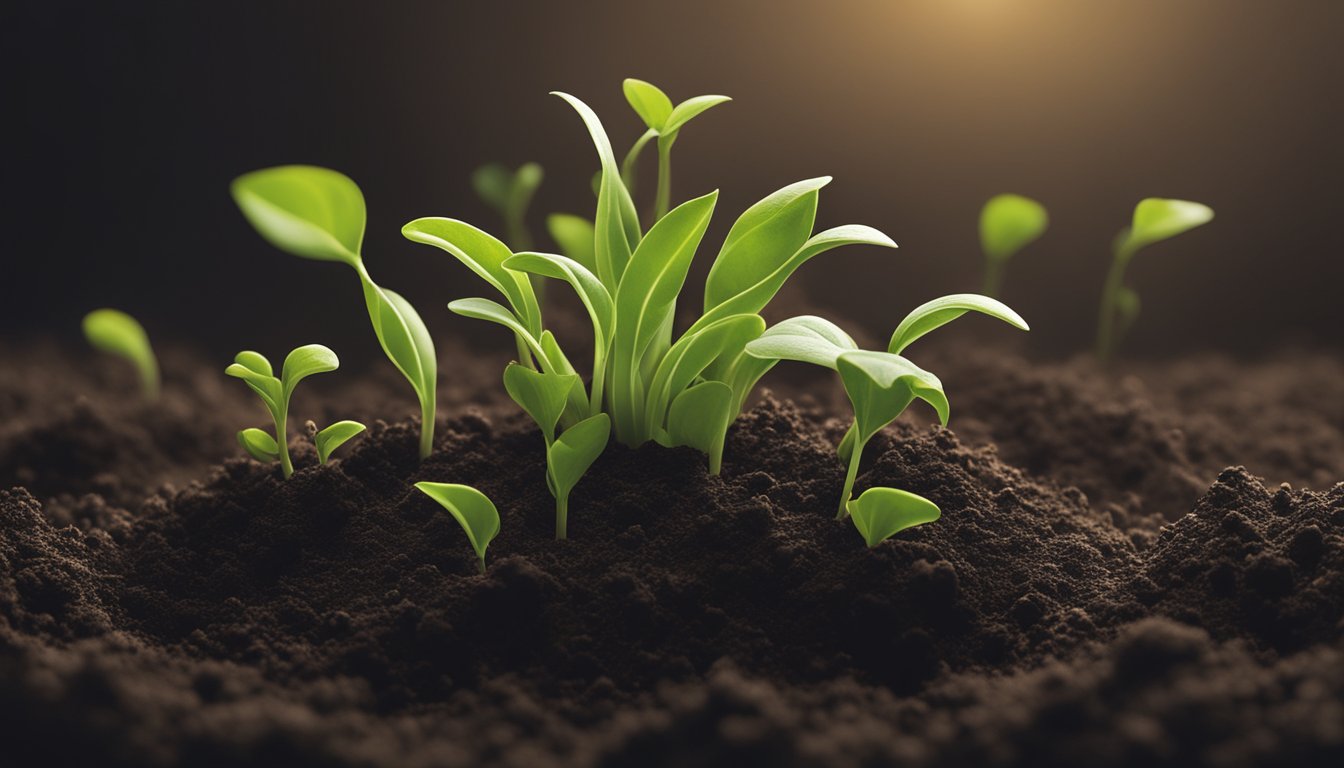TheHerbProf.com is a treasure trove of knowledge for those interested in natural healing and herbal remedies. The website is run by Paul Johnston MD. A naturopathic who has not only received extensive education in the field but also has personal experience in self-healing.
I have researched and gathered information about how long it takes for seeds to sprout in soil. As a gardener, I understand the importance of knowing when to expect the first signs of growth from my newly planted seeds. The germination process is a crucial stage in the growth of plants, and understanding the factors that affect it can help ensure a successful harvest.
When it comes to the sprouting time of seeds in soil, it varies depending on the type of seed, the soil temperature, and moisture. Most vegetable and flower seeds sprout in two weeks or less with ideal soil temperature and moisture. However, certain plants will take as much as three weeks to germinate. It is essential to pay attention to other factors beyond timing, such as the quality of the soil, the amount of light, and the watering schedule. In this article, I will share my knowledge and the information I have gathered on how long it takes seeds to sprout in soil.
Understanding Seed Germination – How Long Does it Take Seeds to Sprout in Soil?
As a gardener, it is essential to understand the process of seed germination. Germination is the process by which a seed becomes a seedling. It is the first step in the growth of a plant. The germination process involves the activation of the seed’s embryo, which leads to the emergence of a radicle (the embryonic root) and the growth of a shoot.
The Germination Process – How Long Does it Take Seeds to Sprout in Soil?
The germination process requires the right conditions for the seed to germinate successfully. The most important factors that influence seed germination are water, temperature, light, oxygen, and soil moisture. A seed needs water to activate the enzymes that break down stored food reserves and initiate the growth of the embryo. The amount of water required depends on the seed’s species and size.
Temperature is another essential factor in seed germination. Each seed has a specific temperature range at which it germinates best. Seeds that require warm temperatures to germinate have a higher germination rate when planted in warm soil. Conversely, seeds that require cooler temperatures to germinate have a higher germination rate when planted in cooler soil.
Light is a factor in the germination process for some seeds. Some seeds require light to germinate, while others require darkness. Seeds that require light to germinate should be sown on the soil surface, while seeds that require darkness should be sown deeper in the soil.
Oxygen is also necessary for seed germination. The seed’s embryo needs oxygen to break down stored food reserves and produce energy for growth.
Soil moisture is another essential factor in seed germination. The soil should be moist but not waterlogged, as excess water can lead to seed rot and poor germination rates.
Factors Affecting Germination – Build Soil Fertility With This Guide Here!
Several factors can affect the rate of seed germination. These include the seed’s age, quality, and the presence of inhibitors. Old seeds have a lower germination rate than fresh seeds, and poor-quality seeds may not germinate at all. Inhibitors are chemicals that can prevent or slow down seed germination. They can be present in the seed coat or the soil.
Understanding the process of seed germination is crucial for successful gardening. The right conditions of water, temperature, light, oxygen, and soil moisture are necessary for seed germination. Several factors can affect the rate of seed germination, including seed age, quality, and the presence of inhibitors. By providing the right conditions, you can maximize the germination rate and ensure a successful harvest.
Preparing Seeds for Planting – How Long Does it Take Seeds to Sprout in Soil?
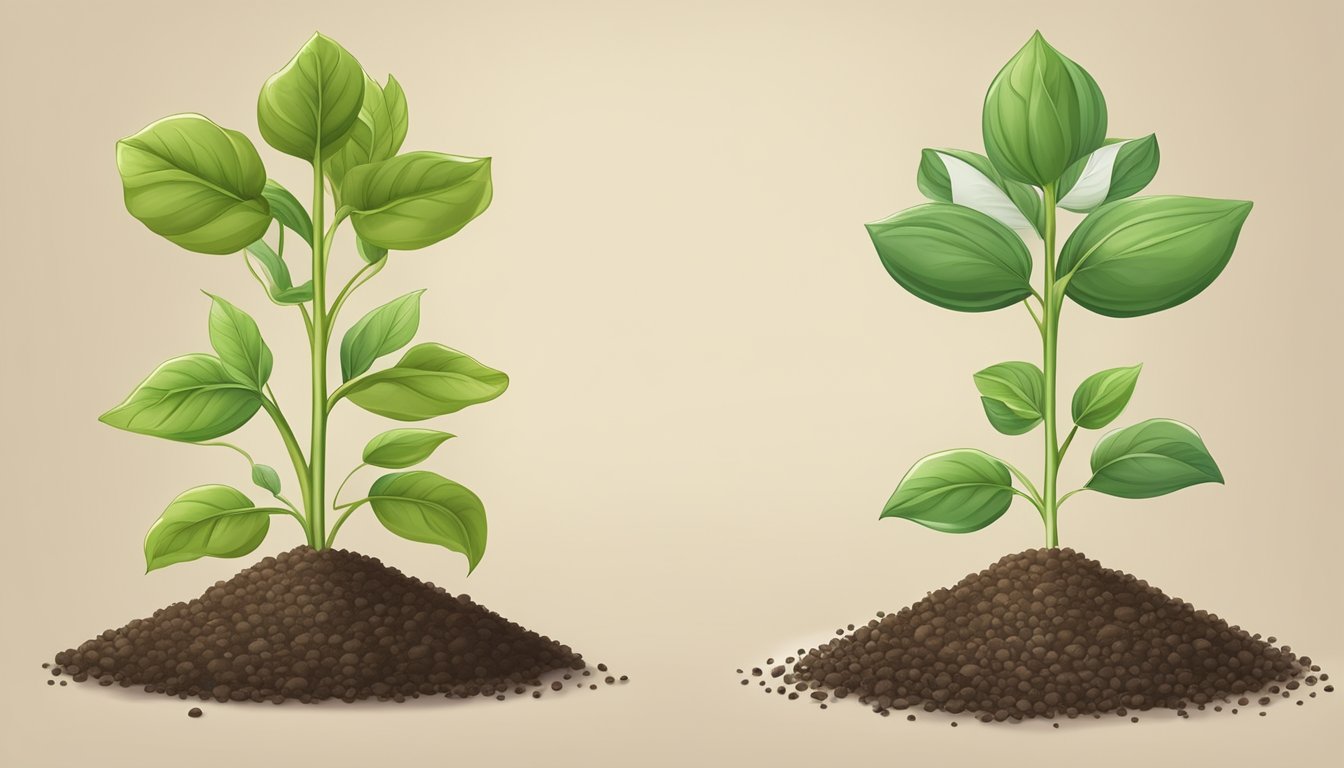
Before planting seeds, it is important to prepare them to ensure that they have the best chance of germinating and growing into healthy plants. In this section, I will discuss some of the steps that I take when preparing seeds for planting.
Seed Selection – How Long Does it Take Seeds to Sprout in Soil?
When selecting seeds, it is important to choose high-quality seeds that are suited to the growing conditions of your garden. Look for seeds that are fresh, as old seeds may not germinate as well. You can check the seed packet for the date that the seeds were packed to ensure that they are fresh.
Pre-Soaking Seeds – Build Soil Fertility With This Guide Here!
Some seeds have a hard seed coat that can make it difficult for them to absorb water and germinate. Pre-soaking seeds can help to soften the seed coat and improve germination rates. To pre-soak seeds, simply place them in a bowl of water and let them soak for several hours or overnight. Be sure to use room temperature water, as hot water can damage the seeds.
Seed Coating and Treatment
In addition to pre-soaking, there are other seed coating and treatment methods that can be used to improve germination rates. For example, some seeds can be lightly scarified to break the seed coat and improve water absorption. Others can be treated with a fungicide to protect against soil-borne diseases.
Overall, preparing seeds for planting is an important step in the gardening process. By selecting high-quality seeds and taking steps to improve germination rates, you can help to ensure that your plants grow strong and healthy.
Soil and Planting Conditions – How Long Does it Take Seeds to Sprout in Soil?
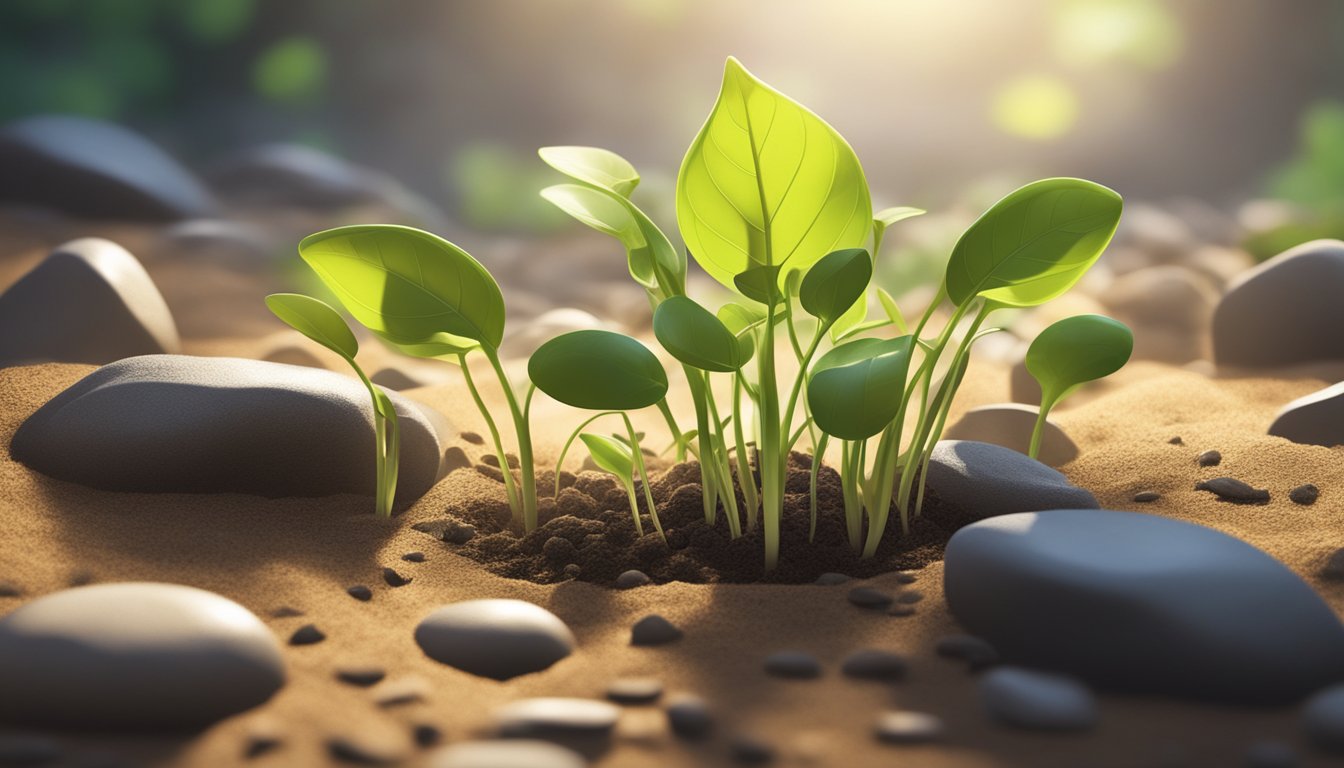
As a gardener, I know that proper soil and planting conditions are crucial for a successful harvest. When it comes to seed germination, there are a few key factors to consider: soil temperature and quality, planting depth and spacing, and watering and moisture control.
Soil Temperature and Quality – How Long Does it Take Seeds to Sprout in Soil?
Soil temperature and quality are two important factors that can affect seed germination. Most seeds require a soil temperature of at least 60°F (15.6°C) to sprout properly. Some seeds, such as tomatoes, peppers, and eggplants, require even warmer soil temperatures of around 70-75°F (21-24°C).
In addition to temperature, soil quality is also important. Seeds need a loose, well-draining soil mix that allows for proper root development. A good soil mix should contain a balance of organic matter, such as compost, and inorganic matter, such as sand or perlite.
Planting Depth and Spacing – Build Soil Fertility With This Guide Here!
Proper planting depth and spacing are crucial for seed germination. Plant seeds too deep, and they may not receive enough light to sprout. Plant them too shallow, and they may dry out or be eaten by birds. As a general rule, plant seeds two to three times their diameter deep.
Spacing is also important to ensure that seeds have enough room to grow. Overcrowding can lead to stunted growth and poor yields. Check the seed packet for specific spacing recommendations.
Watering and Moisture Control
Watering and moisture control are also important factors to consider when planting seeds. Seeds need to be kept moist but not waterlogged. Overwatering can lead to rot and fungal diseases, while underwatering can cause seeds to dry out and fail to germinate.
To ensure proper moisture control, water seeds immediately after planting and then monitor the soil moisture level regularly. A good rule of thumb is to keep the soil consistently moist but not wet. Using a spray bottle or mister can help prevent overwatering and ensure even moisture distribution.
By paying attention to soil temperature and quality, planting depth and spacing, and watering and moisture control, you can ensure successful seed germination and a bountiful harvest.
Seedling Care and Growth – How Long Does it Take Seeds to Sprout in Soil?
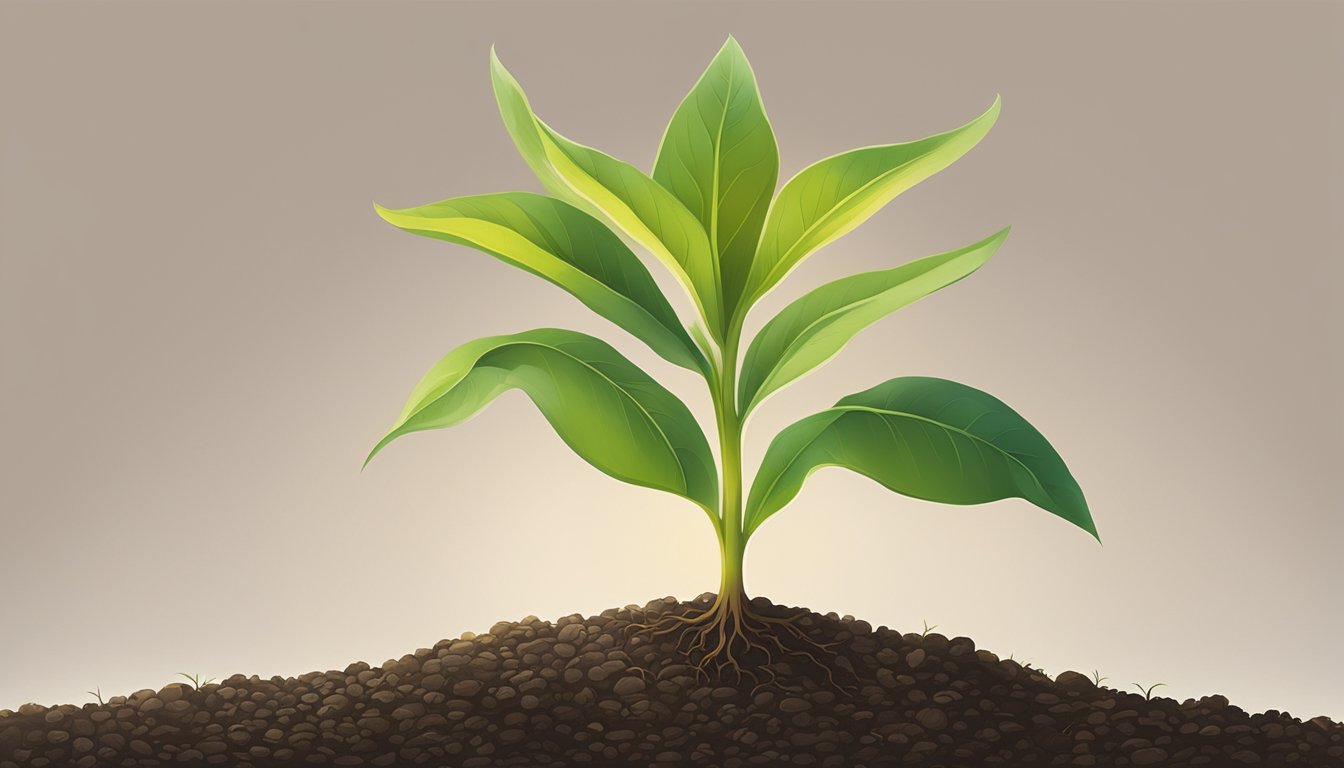
As a gardener, I understand the importance of taking care of seedlings after they have sprouted. Proper care and attention are necessary to ensure that they grow into healthy and robust plants.
Light and Heat Requirements – Build Soil Fertility With This Guide Here!
Light and heat are essential factors for seedling growth. Seedlings need ample light to grow, and the right amount of heat to develop their roots. Too little light can cause seedlings to become leggy and weak, while too much heat can stunt their root growth. Therefore, it is important to keep seedlings in a bright location, but not in direct sunlight. A grow light can also be used to provide sufficient light for seedlings.
Monitoring Seedling Development – How Long Does it Take Seeds to Sprout in Soil?
It is critical to monitor seedling development regularly to ensure that they are growing properly. Seedlings need to be watered regularly, but not overwatered. Overwatering can cause the roots to rot, while underwatering can cause the seedlings to wilt and die. It is also important to monitor the growth of the cotyledon, the first leaves that appear after germination. Once the true leaves have developed, it is time to transplant the seedlings into larger containers.
Transplanting and Repotting
Transplanting and repotting are necessary to ensure that seedlings have enough space to grow. When transplanting seedlings, it is important to handle them gently and avoid damaging the roots. The planting depth should also be maintained to ensure that the seedlings do not become too deep or too shallow. Repotting should be done when the seedlings have outgrown their current container. It is also important to use a good quality potting mix when repotting.
Taking care of seedlings is essential for their growth and development. By providing the right amount of light and heat, monitoring their growth, and transplanting and repotting them when necessary, seedlings can grow into healthy and robust plants.
Common Seed Types and Their Sprouting Times
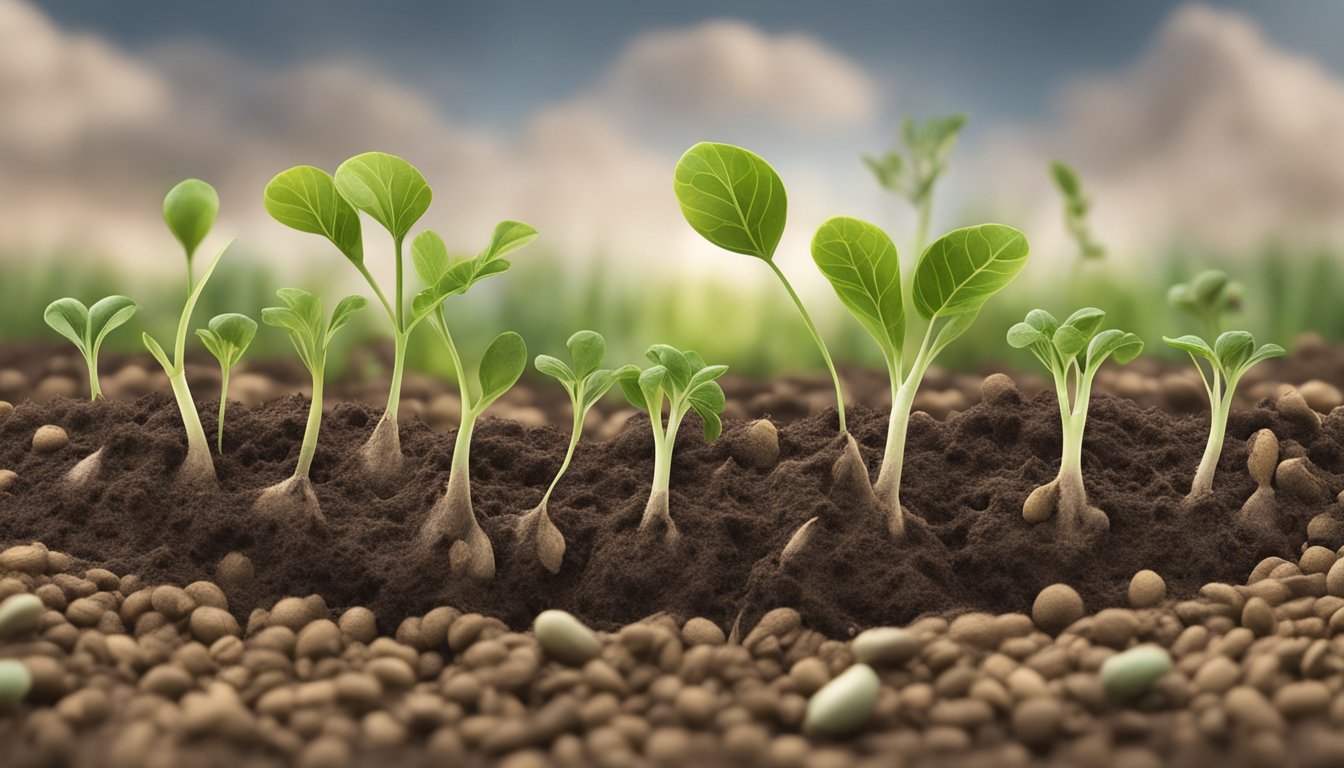
When it comes to growing plants from seeds, it’s helpful to know how long it takes for the seeds to sprout. The sprouting time can vary depending on the type of seed and the conditions in which it is planted. In this section, I will discuss the sprouting times for different seed types, including vegetable seeds, flower seeds, and herb and fruit seeds.
Vegetable Seeds
Vegetable seeds are some of the most commonly planted seeds in gardens. The sprouting time for vegetable seeds can vary depending on the type of vegetable. For example, lettuce seeds typically sprout within 7-10 days, while pepper seeds can take up to 21 days to sprout. Pea seeds usually sprout within 7-14 days, and tomato seeds take around 7-14 days as well. Onion seeds can take up to 21 days to sprout, while spinach seeds usually sprout within 7-14 days. Cauliflower seeds can take up to 14-21 days to sprout, and eggplant seeds usually sprout within 7-14 days.
Flower Seeds – Build Soil Fertility With This Guide Here!
Flower seeds are another popular type of seed to plant in gardens. The sprouting time for flower seeds can vary depending on the type of flower. For example, marigold seeds typically sprout within 5-7 days, while zinnia seeds can take up to 10-14 days to sprout. Sunflower seeds usually sprout within 7-14 days, and cosmos seeds take around 7-10 days to sprout. Petunia seeds can take up to 10-21 days to sprout, while nasturtium seeds usually sprout within 7-14 days.
Herb and Fruit Seeds – How Long Does it Take Seeds to Sprout in Soil?
Herb and fruit seeds are also commonly planted in gardens. The sprouting time for herb and fruit seeds can vary depending on the type of herb or fruit. For example, basil seeds typically sprout within 5-10 days, while cilantro seeds can take up to 14 days to sprout. Strawberry seeds usually sprout within 14-21 days, and watermelon seeds take around 7-10 days to sprout.
It’s important to note that the sprouting times listed above are just general guidelines. The actual sprouting time can vary depending on factors such as soil temperature, moisture levels, and planting depth. It’s also important to follow the specific instructions for planting each type of seed to ensure the best results.
Troubleshooting Poor Germination – Build Soil Fertility With This Guide Here!
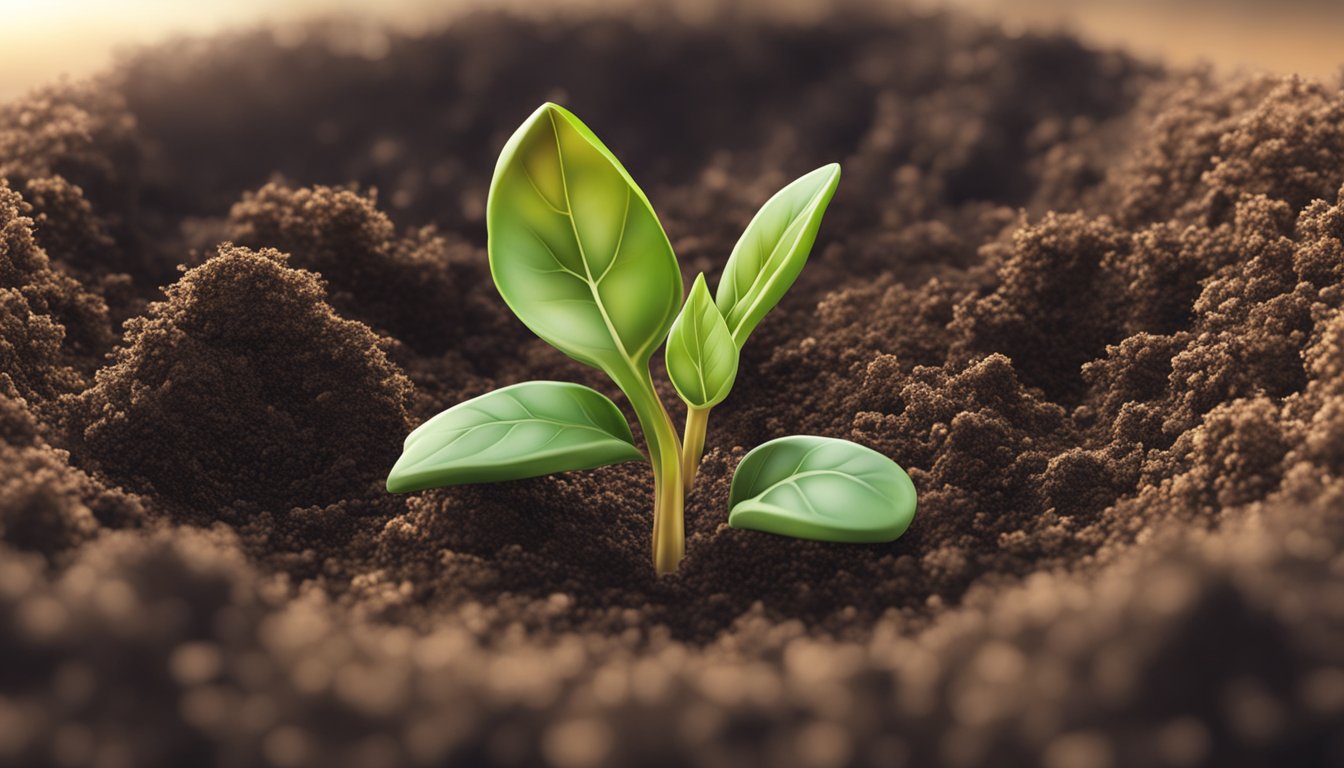
When it comes to seed germination, there are several factors that can affect the success rate. If you’re having trouble getting your seeds to sprout, here are some common issues to look out for:
Dealing with Disease and Pests – How Long Does it Take Seeds to Sprout in Soil?
One of the most common reasons for poor seed germination is disease and pests. If your seeds are infected with a fungal or bacterial disease, they may not be able to sprout. Similarly, if pests such as insects or rodents are eating your seeds, they won’t be able to grow.
To prevent disease and pests, it’s important to use high-quality seeds and to plant them in clean, healthy soil. You can also use natural pest control methods, such as companion planting, to keep pests at bay.
Environmental Stress Factors – Build Soil Fertility With This Guide Here!
Environmental stress factors can also affect seed germination. If the soil is too dry or too wet, for example, your seeds may not be able to sprout. Similarly, if the temperature is too hot or too cold, your seeds may not be able to grow.
To prevent environmental stress, make sure to plant your seeds at the right time of year and in the right conditions. You can also use techniques such as mulching and watering to help regulate the soil temperature and moisture levels.
Seed Viability and Expiration
Finally, it’s important to consider the viability and expiration of your seeds. If your seeds are old or have been improperly stored, they may not be able to sprout. Similarly, if your seeds have expired, they may not be able to grow.
To ensure the viability of your seeds, make sure to store them in a cool, dry place. You can also test the viability of your seeds by performing a germination test before planting. Simply place a few seeds in a damp paper towel and wait to see if they sprout.
Overall, troubleshooting poor seed germination can be a frustrating process. However, by taking the time to address these common issues, you can increase your chances of success and enjoy a bountiful harvest.
Advanced Techniques and Tips – How Long Does it Take Seeds to Sprout in Soil?
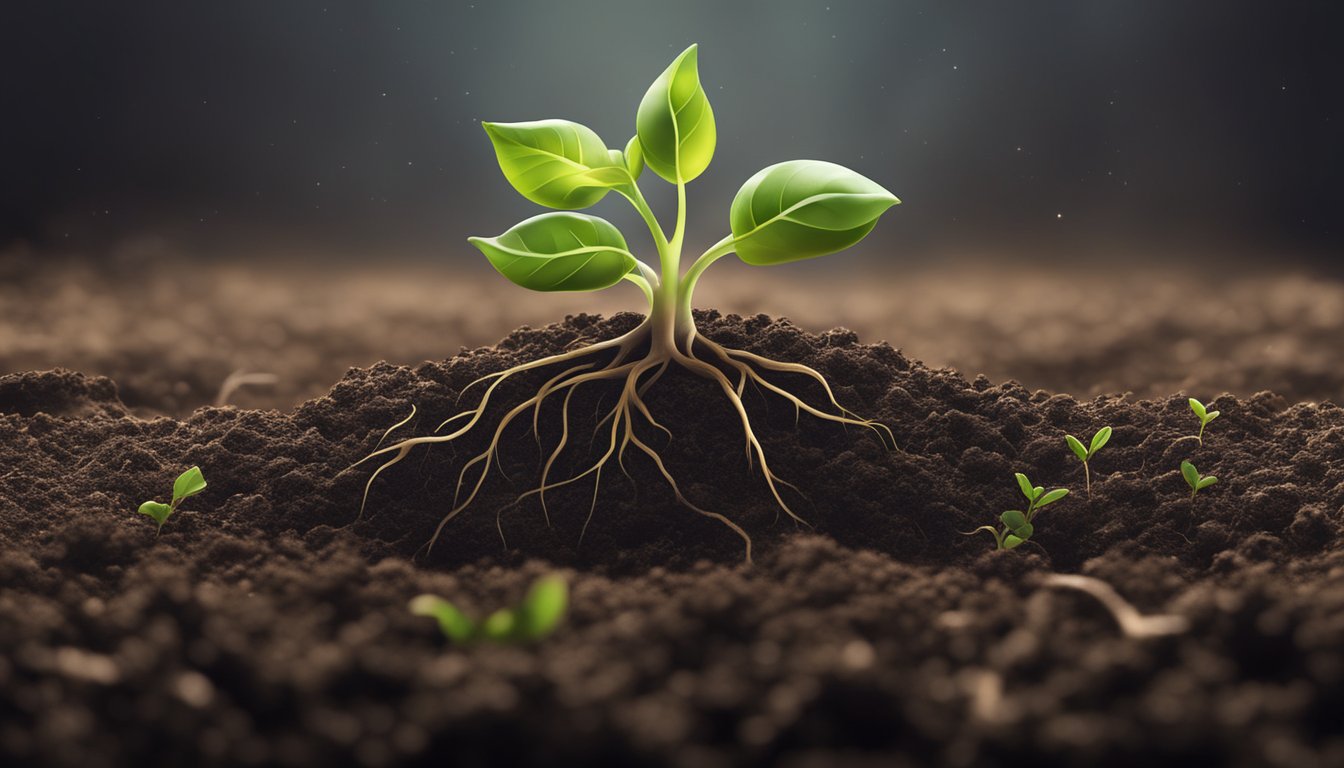
Using Growth Enhancers
I have found that using growth enhancers can help speed up the germination process and increase the chances of successful sprouting. One such enhancer is seaweed extract, which is rich in micronutrients and can help stimulate root growth. Another enhancer is mycorrhizal fungi, which form a symbiotic relationship with plant roots and help improve nutrient uptake. However, it is important to follow the instructions on the label and not overuse these products.
Seed Starting Mixes and Additives – Build Soil Fertility With This Guide Here!
The type of seed starting mix used can also affect the germination process. A good seed starting mix should be light, well-draining, and sterile to prevent the growth of harmful bacteria and fungi. Adding perlite, vermiculite, or sand can help improve drainage, while adding compost or worm castings can help provide nutrients. However, it is important to avoid using garden soil or potting soil, as they can be too heavy and can contain harmful pathogens.
Optimizing Germination Timing
Timing is also an important factor to consider when trying to optimize germination. Some seeds require specific temperatures or light conditions to germinate, while others may need to be stratified (exposed to cold temperatures) or scarified (scratched or nicked) to break their dormancy. It is important to research the specific requirements for each type of seed and to follow the instructions on the seed packet.
Overall, using growth enhancers, choosing the right seed starting mix, and optimizing germination timing can all help improve the chances of successful seed germination. By following these tips and techniques, you can ensure that your seeds sprout quickly and thrive in your garden.
The Seed of Knowledge: Sprouting Seeds and The Herb Prof
Let’s dig into the topic of how long it takes seeds to sprout in soil and its connection to our herbal paradise, theherbprof.com. Ready to sow some knowledge?
Firstly, sprouting seeds is a process of patience and anticipation. It’s about waiting for that first green shoot to emerge from the soil. Sounds familiar? That’s because theherbprof.com does the same for your herbal wisdom!
Secondly, both sprouting seeds and theherbprof.com are about nurturing growth. Just like a seed needs the right conditions to sprout, theherbprof.com provides the right environment for your herbal knowledge to flourish.
Lastly, they both aim to enrich our lives. Sprouting seeds bring the joy of gardening, while theherbprof.com enlightens us about the wonders of herbs.
So, there you have it! Sprouting seeds and theherbprof.com are two sides of the same leaf. They both symbolize patience, nurturing growth, and enrichment. Now, isn’t that a seed-sational piece of information to share at your next garden party? Keep growing, folks!
References – How Long Does it Take Seeds to Sprout in Soil?
Little Herb Encyclopedia, by Jack Ritchason; N.D., Woodland Publishing Incorporated, 1995
The Ultimate Healing System, Course Manual, Copyright 1985, Don Lepore
Planetary Herbology, Michael Tierra, C.A., N.D., Lotus Press, 1988
Handbook of Medicinal Herbs, by James A. Duke, Pub. CRP Second Edition 2007
The Complete Medicinal Herbal, by Penelope Ody, Published by Dorling Kindersley
Check the Following Articles!
Best Prepper Garden: How to Be Self-Sufficient
Propagating Succulents in Water: A Comprehensive Guide
Grow Coffee in Greenhouse: Tips For Successful Cultivation
Frequently Asked Questions – How Long Does it Take Seeds to Sprout in Soil?
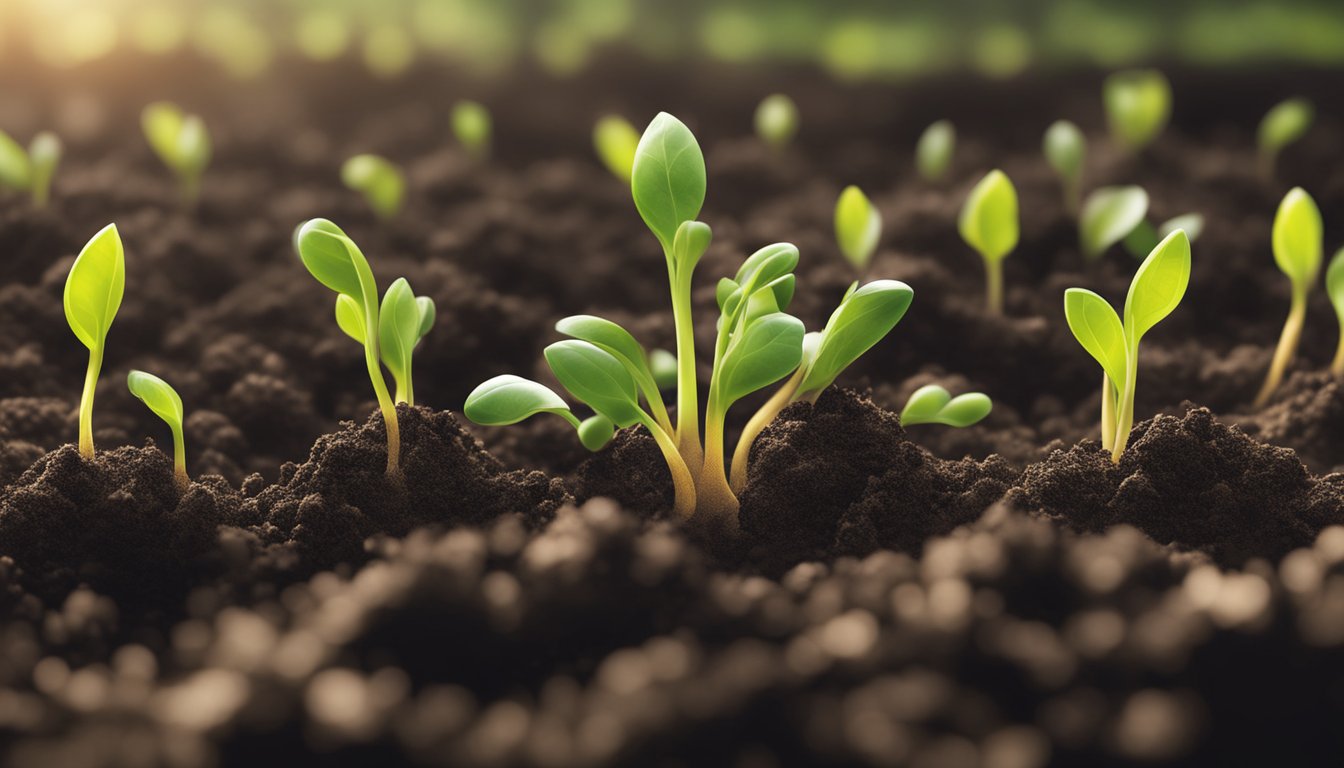
What are the typical germination times for common garden seeds?
The time it takes for seeds to sprout in soil varies depending on the type of plant. For example, lettuce and tomato seeds typically germinate within 7-14 days, while parsley and pepper seeds can take up to 21 days to sprout. On the other hand, some seeds like carrots and parsnips can take up to 3 weeks to germinate. You can find more information on typical germination times for common garden seeds in this source.
What factors can affect the speed of seed germination in soil?
Several factors can affect the speed of seed germination in soil. These include soil temperature, moisture, air circulation, light, and seed quality. Seeds that are old or have been improperly stored may have lower germination rates. Poor soil quality or improper planting depth can also affect seed germination. You can find more information on factors that can affect seed germination in soil in this source.
How can you tell if a seed is viable for planting?
Before planting, it’s important to check if the seeds are viable. One way to test seed viability is to place the seeds in a bowl of water. Viable seeds will sink to the bottom, while non-viable seeds will float. You can also perform a germination test by planting a few seeds in a small container with soil and monitoring their growth. If the seeds sprout within the expected timeframe, they are likely viable. You can find more information on testing seed viability in this source.
What pre-planting treatments can expedite seed sprouting?
There are several pre-planting treatments that can help expedite seed sprouting. One common method is to soak the seeds in water for a few hours or overnight before planting. This can help soften the seed coat and promote germination. Another method is to scarify the seeds by lightly scratching or nicking the seed coat with sandpaper or a knife. This can help break down the hard outer layer of the seed and allow moisture to penetrate. You can find more information on pre-planting treatments in this source.
How does soil temperature influence seed germination rates?
Soil temperature plays a crucial role in seed germination rates. Most seeds germinate best at a soil temperature of 65-75°F (18-24°C). If the soil temperature is too low, seed germination may be slow or nonexistent. On the other hand, if the soil temperature is too high, the seeds may not germinate at all or may be susceptible to fungal diseases. You can find more information on soil temperature and seed germination rates in this source.
What are the signs that seeds are properly germinating in soil?
The first sign that seeds are properly germinating in soil is the emergence of the seedling from the soil. As the seedling grows, you should see the emergence of the first true leaves. The seedling should also appear healthy and vibrant, with no signs of wilting or discoloration. If the seedlings are growing slowly or appear weak, it may be a sign of poor soil quality or improper growing conditions. You can find more information on signs that seeds are properly germinating in soil in this source.
